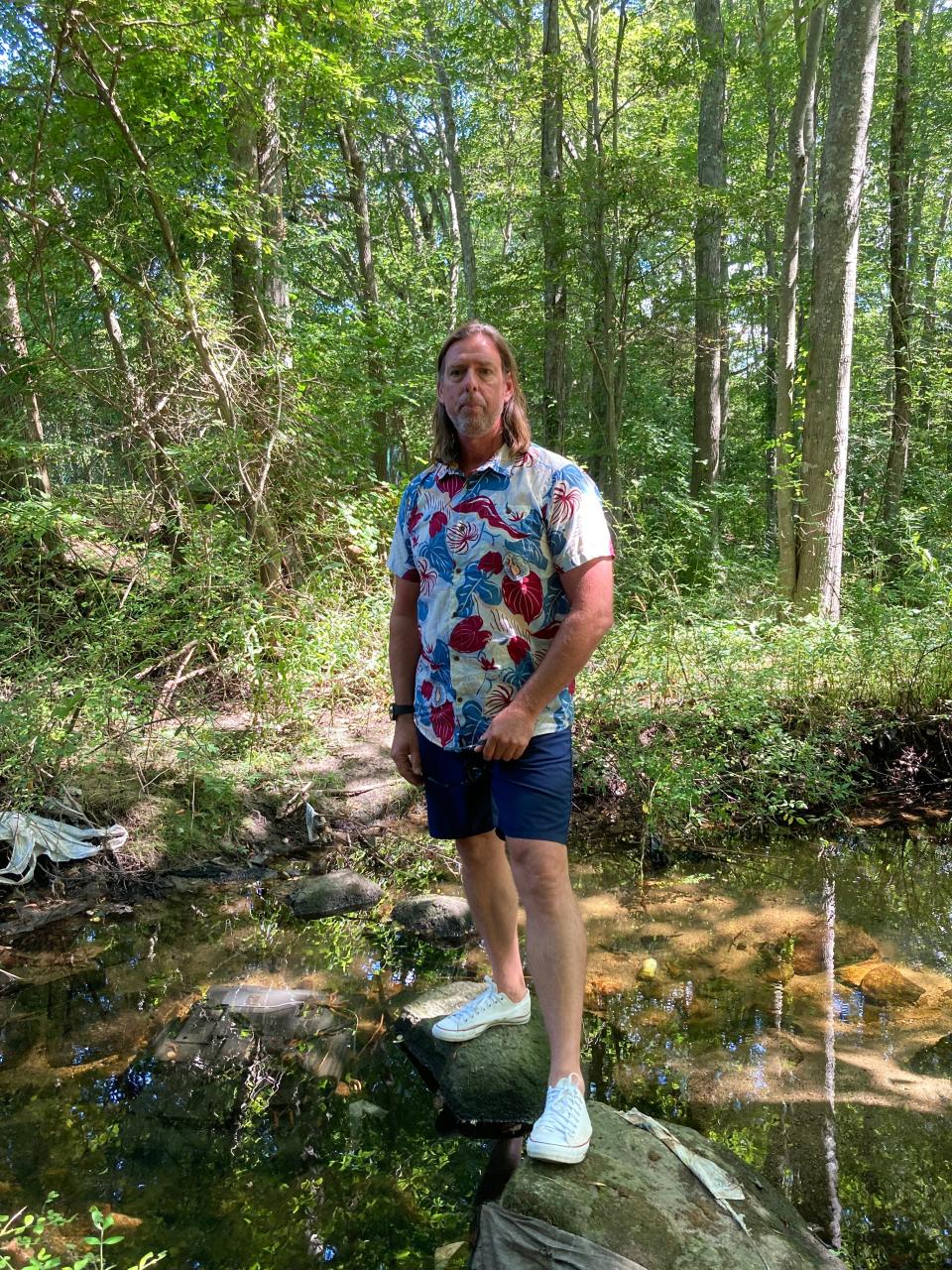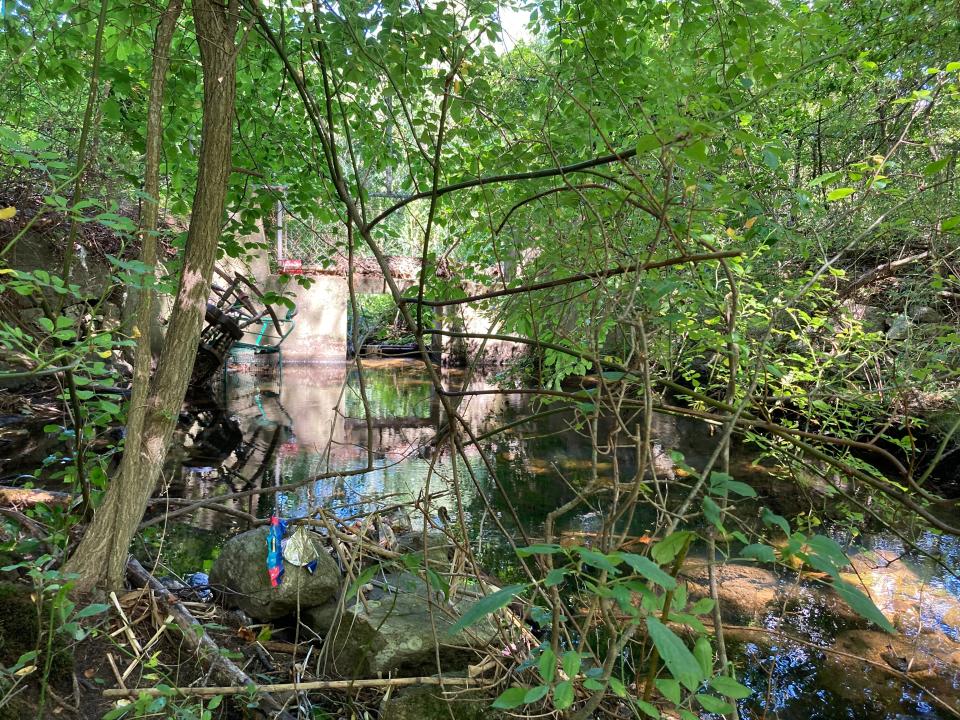Septic systems in New Bedford and Dartmouth pose a threat to Buttonwood Brook.
Buttonwood Brook winds its way through dozens of local neighborhoods in New Bedford and Dartmouth, and it's the steady flow of nitrogen and other nutrients from septic systems in many of those neighborhoods that have a lasting negative impact on water quality.
The Buttonwood to Bay Project, an Environmental Protection Agency grant-funded partnership, seeks to identify pollution sources within the Buttonwood Brook watershed, develop natural solutions and protect land and water resources for future generations.
Within this core mission, the Buzzards Bay Coalition and its project partners are also working to address larger issues like climate resilience and groundwater pollution caused by septic systems that are distributed throughout the Buzzards Bay watershed.

Project Manager Dan Goulart said the project has reached a new phase and is moving from data collection to drawing broad conclusions about pollution sources and potential solutions.
Project partners, including New Bedford and Dartmouth, are coming together to identify sites where green infrastructure and nature-based solutions can be implemented to improve water quality in the brook and in its receiving waters at Padanaram Harbor.
Up and down Buttonwood Brook, over 60 outfalls discharge untreated stormwater from streets, parking lots, and rooftops into the brook. Goulart said addressing the impact of stormwater on the brook and its surrounding habitat is critical for a variety of reasons.
He said a lot of the same issues that impact our coastal water quality are also impacting our resilience to extreme weather events like intense rainfall, heatwaves and drought.
Observations at the brook
Goulart is out on the brook throughout the year observing how it responds to these events, and he’s seeing an ecosystem that’s been stripped of its ability to adapt to or buffer these events. He said there’s a lot of localized flooding during heavy rain events and the brook goes dry quickly if there’s a drought.
"Much of this is due to how urbanization and suburban development has changed the landscape over time,” he said. “We’ve paved a lot more surface area, filled wetlands and floodplains, and squeezed the brook into a narrow channel where it has no room to expand.”

Alternate solutions like restoring and protecting degraded wetlands, floodplains and stream channels are considered to be the most cost-effective method going forward. He said this approach provides spaces where water can slow down and filter through wetland vegetation. These areas act like a sponge that absorbs water and pollution before it moves downstream and reaches the coast.
He said ecosystem restoration has been used successfully in many other areas and provides a host of co-benefits such as increased flood resilience, reduced heat island effect, expanded green space and improved air quality.
Weekly home sales: Cozy cape in New Bedford sells for over $500K
“With that said, we will still face declining coastal water quality if we fail to address the steady flow of nitrogen that leaches into our groundwater from septic systems,” he said. “It's a complex issue, but we absolutely must come together at the local level and develop long-term workable solutions.”
He said the entire community needs to come together on this and come up with solutions that are going to solve both of those in one fell swoop rather than trying to continue putting Band-Aids on it, but it’s really tough in this environment because everything is already built in a lot of these places.
"This this makes restoration and protection of the remaining natural areas even more critical," he said.
The watershed dynamics
Goulart said the watershed has two different dynamics that are driven by dense development and a lack of wastewater infrastructure. Data collected at 18 sites up and down the brook over the last year and a half shows that in the northern end, in New Bedford, where most of the dense urban development exists, it is largely contributing phosphorus and bacteria during rain events.
He said these pollutants along with small amounts of nitrogen wash off paved surfaces and rooftops and make their way into the brook very quickly via storm drains. While some stormwater driven pollution does occur in the southern part of the watershed, in Dartmouth, it is largely dominated by a steady flow of nitrogen that enters the brook and bay through shallow groundwater.
These elevated levels of nitrogen can be attributed to the high number of septic systems that remain in the lower watershed.
Properties with access to sewer that are still on septic
Based on publicly available information, he said the Coalition estimates that there are still hundreds of homes on septic systems in the Buttonwood Brook watershed. Roughly 80 of those are in New Bedford, a city that has long had access to sewer.
He said the data also shows the number of homes on septic is much larger in the lower end of the system. In rural areas of Dartmouth without sewer infrastructure, wastewater from every home is discharged into the ground through a Title 5 septic system. In areas of Dartmouth with sewer infrastructure, a significant number of homes remain on septic despite a town ordinance that requires them to connect.
He said the aggregate effect of all these homes discharging to groundwater is a slow, steady feed of nitrogen and other nutrients that have a lasting negative impact on water quality.
“The majority of urban stormwater runoff comes from the northern end of the system during rain events,” he said. “There’s sort of a story of two different inputs from dry weather and wet weather, but the dry weather and the nitrogen inputs from the septic systems are much larger than the nitrogen we’re seeing coming off the roadways.”
What comes next?
Goulart said solving water quality and resilience issues will take serious engagement and planning from local officials to target all the different pollution sources, and in the short term that will involve planning and implementing green infrastructure and nature-based solutions to restore critical ecosystems like wetlands, floodplains and streams.
He said that planning is underway with proposed projects being funded through a combination of state, federal and private grants and local matching grants.
“It really takes a partnership with the municipalities to plan our way through this and come up with short, medium and long-term strategies on how we approach this and address all these water quality and resilience issues,” he said.
He said they are seeing less frequent but more intense rainfall events and hotter spikes in temperature that can impact water quality and impact how much water flows into the brook system at once. He said deluge events are causing flooding and damage, impacting personal property and public infrastructure.
“Green infrastructure and restoring the natural systems that are there by opening up flood plains, restoring wetlands and putting green infrastructure in place to intercept some of the water before it gets into the brook can buffer all of those extreme water events while simultaneously helping to filter the water,” he said.
He said the more water they can put back into the ground locally on site, the more of it travels to the brook after being filtered. He said there are ongoing planning efforts with Dartmouth to identify stormwater remediation opportunities and map out the existing septic systems.
Incentives to connect to sewer line
He said once the septic issue is mapped, they can begin developing practical solutions, including offering incentives for people to connect to an existing sewer line and expanding the sewer infrastructure to cover the more populated parts of town.
In sparsely populated areas, he said alternatives like nitrogen removing septic systems and cluster wastewater treatment systems are viable alternatives and could be phased in over time with financial assistance. He suggested prioritizing areas that are closest to vulnerable natural resources like streams, wetlands and estuaries like Apponagansett Bay.
From what he has seen over the last two years, and knowing the area having grown up here, Goulart said the trajectory 50 years from now will be a lot bleaker than a lot of people may want to acknowledge.
“I think we would see the loss of recreational use in a lot of these waterways and a lot of algae blooms, harmful algae blooms similar to what people are seeing on the Cape during hot summer days,” he said. “That would impact activities like swimming, fishing and shellfishing as well as local tourism.
The financial impact
Goulart said communities that plan and implement green infrastructure and nature-based solutions are more resilient to extreme weather events, have cleaner water and tend to have a better overall quality of life. He said homeowners also enjoy higher property values and tend to pay lower insurance premiums.
“We want to partner with the municipalities, find this funding and help them compete for the grants," he said.
He said New Bedford has done a lot of work with stormwater planning and a major stormwater remediation project along the Kempton corridor between Rockdale Avenue and Route 140 and in partnership with the Buzzards Bay Coalition and Friends of Buttonwood Park will use state and federal grant funding to greatly reduce negative water quality impacts in this urbanized area.
He said there’s also a partnership with the Dartmouth National Resources Trust to move forward with ecological restoration in the lower portion of the brook that would expand flood storage to create resilience and re-establish fish passages through dam removal.
“It’s going to be a comprehensive ecological restoration that removes dams, opens up floodplains and really restores the ability of fish to come up into the brook like they used to, but also open up a lot of flood storage to create resilience and remove pollutants so the water going down to the bay will be a lot cleaner,” he said.
He said the Buttonwood Park Zoo has been a willing partner in finding solutions to legacy issues including mitigating bacterial pollution and has provided unfettered access to the whole facility for water testing and sensor placement.
The zoo and Buzzard Bay Coalition are working with experts from the Stormwater Innovation Center in Providence to pinpoint pollution sources, explore what has worked in other zoos and develop tailored solutions for Buttonwood.
A consultant’s work begins
A consultant hired by the coalition is taking all the data and developing a comprehensive watershed plan. As part of that process, they will work with project partners to identify 10 sites within the watershed that could have the highest impact on resilience and water quality for local communities.
A conceptual design will be completed for each of these sites that outlines the planned restoration, expected results and how those might affect the community. They will be reviewed by the project partners and local stakeholders who will select at least three sites for advancement to full design, permitting and construction.
“We’ll hope to have key leaders from both municipalities in one room to talk about the biggest problems and how we can come together and collectively partner on solutions and the grants that fund them,” he said.
Standard-Times staff writer Kathryn Gallerani can be reached at kgallerani@gannett.com. Follow her on Twitter: @kgallreporter. Support local journalism by purchasing a digital or print subscription to The Standard-Times today.
This article originally appeared on Standard-Times: Buttonwood to Bay Project seeks to identify pollution sources

